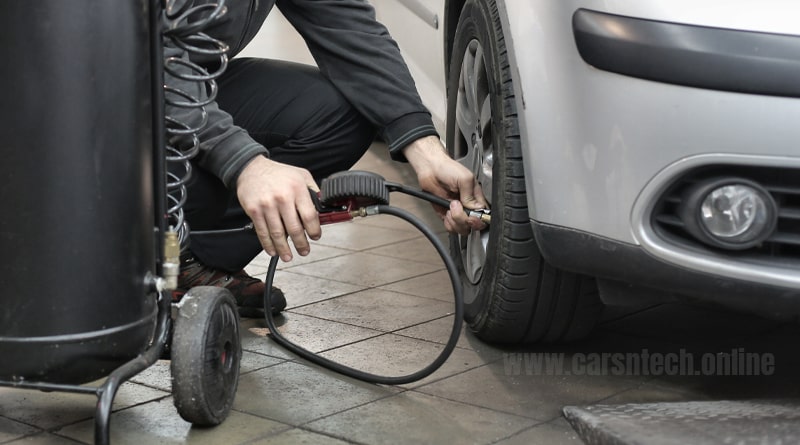What is TPMS & How Does it Work? Understanding Tire Pressure Monitoring Systems
Imagine driving on the highway, wind in your hair, music playing softly in the background, when suddenly, a warning light flashes on your dashboard. It’s the Tire Pressure Monitoring System (TPMS), and it’s here to tell you that something’s not quite right with your tires. In this article, we’ll delve into the world of TPMS, its significance, its working mechanisms, and how it contributes to road safety.
Introduction to TPMS
TPMS, or Tire Pressure Monitoring System, is a crucial automotive technology designed to ensure your safety on the road. Its primary function is to alert you when your tire pressure drops below the recommended levels, which can lead to compromised handling, reduced fuel efficiency, and increased risk of accidents.
The History Behind TPMS
Before the era of TPMS, drivers had to rely on manual tire pressure checks using a tire gauge. This practice was not only inconvenient but also contributed to numerous accidents caused by underinflated tires. In response, the US government enacted the TREAD Act in 2007, mandating the inclusion of TPMS in vehicles to address this safety concern.
The Importance of Maintaining Proper Tire Pressure
Proper tire pressure is vital for safe driving. Underinflated tires can lead to decreased traction, longer braking distances, and an increased chance of blowouts. On the other hand, overinflated tires cause a decreased grip, harsher ride, and uneven tire wear.
While we often hear about the dangers of underinflated tires, the effects of overinflated tires are equally significant and can have detrimental effects on your driving experience and vehicle maintenance. In this article, we’ll delve into the world of overinflated tires, exploring how they can impact ride comfort, grip, and tire wear.
The Consequences of Underinflated Tires
Underinflated tires can set off a chain reaction of adverse events, impacting various aspects of your driving performance. The next time you ignore that warning light, remember that the consequences extend beyond a mere inconvenience.
Traction: A Vital Aspect of Road Safety
Traction is the foundation of safe driving. Adequate tire pressure ensures that your tires grip the road effectively, maintaining control even in challenging conditions. Underinflated tires compromise traction, particularly on wet or slippery surfaces. This deficiency in grip increases the likelihood of skids and loss of control, endangering both you and fellow road users.
Longer Braking Distances: A Recipe for Accidents
Imagine needing to make a sudden stop. The ability to brake promptly can be a lifesaver. Underinflated tires, however, increase braking distances. With less contact area on the road, it takes longer for your vehicle to come to a halt, heightening the risk of rear-end collisions and accidents.
Blowouts: When Pressure Drops Lead to Catastrophe
The most dreaded consequence of underinflated tires is the increased chance of blowouts. When a tire is significantly low on pressure, its sidewalls flex excessively. This generates heat, weakens the tire’s structure, and increases the chances of a catastrophic blowout, especially at high speeds. A blowout can result in loss of control and potentially fatal accidents.
Preventive Measures: Ensuring Optimal Tire Pressure
Prevention is the key to avoiding the perils of underinflated tires. Regularly check your tire pressure using a reliable gauge, and ensure it matches the manufacturer’s recommendations. Not only does this enhance safety, but it also promotes fuel efficiency and extends tire life.
The Impact of Overinflated Tires
Many drivers assume that more air in their tires translates to better performance, but that’s not entirely true. Overinflating your tires beyond the manufacturer’s recommended levels can lead to a host of issues that compromise both safety and driving enjoyment.
Riding Comfort and Overinflation
Contrary to the belief that higher tire pressure yields a smoother ride, overinflated tires can result in a harsher and less comfortable driving experience. With less cushioning effect, your tires are less able to absorb road imperfections and shocks, leading to a bumpy and uncomfortable journey. Imagine driving over a pothole with tires that are as taut as a drum – it’s far from a pleasant experience.
Grip and Handling Concerns
Maintaining proper tire pressure is essential for optimal grip and handling. Overinflated tires have a smaller contact patch with the road, reducing the amount of rubber in contact with the surface. This translates to compromised traction, especially in wet or slippery conditions. Your tires are less capable of gripping the road, increasing the risk of skidding and loss of control, particularly during sudden maneuvers or emergency stops.
Uneven Tire Wear: The Consequence of Overinflation
Your tires’ tread wears down over time due to friction with the road. However, overinflated tires wear out unevenly. The center of the tread bears the majority of the load, resulting in accelerated wear in the middle of the tire. This uneven wear pattern not only reduces the lifespan of your tires but also affects handling and braking performance.
Maintaining Optimal Tire Pressure
Finding the right balance is key. To avoid the pitfalls of overinflation, regularly check your tire pressure using a reliable gauge and follow the manufacturer’s recommendations. Optimal tire pressure ensures even tread wear, better fuel efficiency, and a smoother ride, contributing to your safety and the longevity of your tires.
Types of TPMS: Indirect and Direct
Indirect TPMS: How Does it Work?
Indirect TPMS operates by utilizing wheel speed sensors commonly found in anti-lock brake systems. These sensors monitor the rate of wheel revolutions, allowing the onboard computer to compare this data with other vehicle operation metrics. If a wheel is spinning faster than expected, it indicates underinflation, triggering the TPMS warning light.
Advantages of Indirect TPMS
- Relatively inexpensive compared to direct TPMS
- Requires less maintenance and programming over time
- Simpler installation and maintenance process
Disadvantages of Indirect TPMS
- May lose accuracy with changes in tire size
- Unreliable when tires are unevenly worn
- Requires reset after tire inflation or rotation
Direct TPMS: How Does it Work?
Direct TPMS employs pressure monitoring sensors within each tire to measure specific pressure levels. These sensors can also provide tire temperature readings, enhancing accuracy. The data collected is sent to a central control module, which analyzes it and transmits alerts to the dashboard when pressure is too low.
Advantages of Direct TPMS
- Provides actual tire pressure readings from within the tire
- Accurate regardless of tire rotations or replacements
- Simple resynchronization after tire maintenance
- Long-lasting sensor batteries (about a decade)
- May be integrated with the vehicle’s spare tire
Disadvantages of Direct TPMS
- Higher cost compared to indirect TPMS
- Resynchronization might require specialized tools
- Non-serviceable sensor batteries necessitate full replacement
- Proprietary systems can complicate installation and servicing
- Sensors vulnerable during tire mounting/demounting
Ensuring Safety Through TPMS
Although indirect and direct TPMS systems operate differently, they share the same goal – to alert drivers of underinflated tires. However, TPMS isn’t a substitute for regular manual tire pressure checks. Think of it as an additional tool in your maintenance arsenal.
Conclusion
Tire Pressure Monitoring Systems have revolutionized the way we maintain tire pressure and ensure road safety. Whether indirect or direct, TPMS technology plays a pivotal role in preventing accidents, reducing fuel consumption, and enhancing the overall driving experience. So, the next time that TPMS warning light illuminates, remember that it’s not just a symbol – it’s a reminder to keep your tires properly inflated and yourself safe on the road.
Frequently Asked Questions (FAQs)
- Q: Is TPMS necessary for all vehicles?
- A: Most vehicles sold in the United States since 2007 are required to have TPMS due to safety regulations.
- Q: Can TPMS replace manual tire pressure checks?
- A: No, TPMS should be used in conjunction with regular manual pressure checks for optimal safety.
- Q: What is the recommended frequency for checking my tire pressure?
- A: It’s recommended to check tire pressure at least once a month and before long trips.
- Q: Are TPMS sensors replaceable?
- A: Yes, TPMS sensors can be replaced, but it’s advisable to have an experienced technician handle it.
- Q: Can I rely solely on TPMS alerts for tire maintenance?
- A: While TPMS alerts are valuable, manual checks provide a more comprehensive view of tire health.

